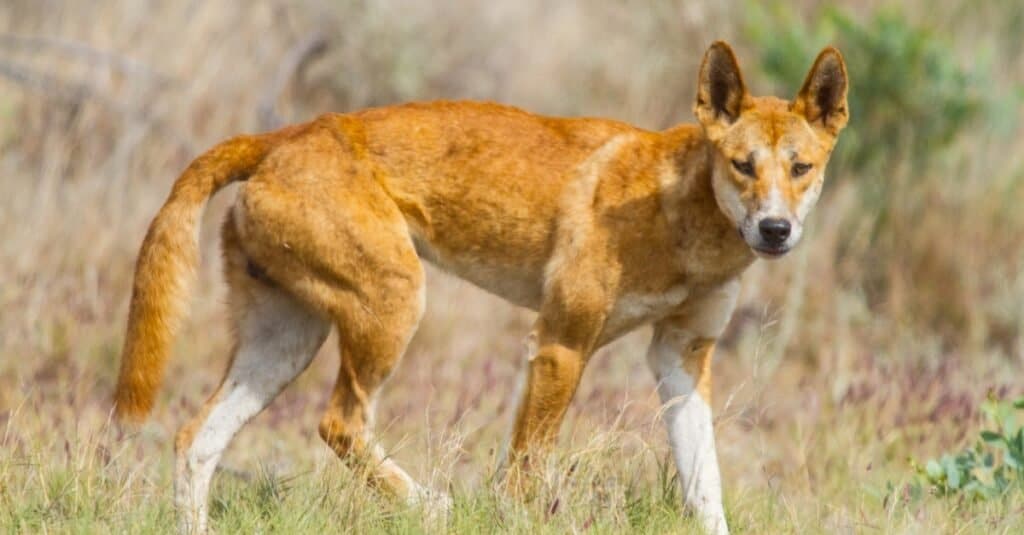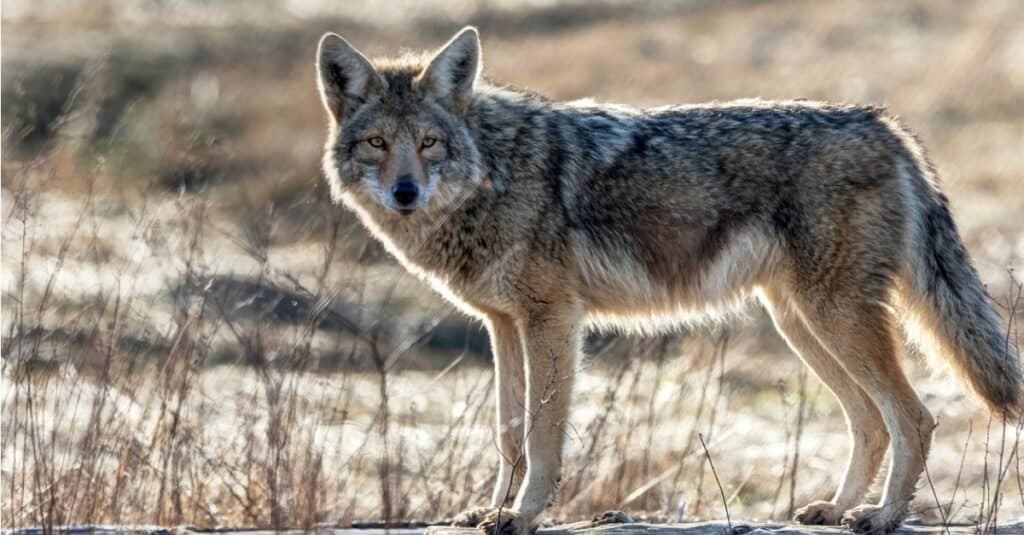Dingoes vs coyotes are both medium sized canines that are highly adaptable and live in a variety of different habitats. They are both excellent predators and are capable of hunting and killing prey much larger than themselves. However, there are actually a lot of differences between coyotes and dingoes.
Although dingoes are native to Australia and coyotes to North America, they both bear a strong resemblance to wolves. However, you might be surprised to find out which one actually is a wolf subspecies.
Aside from the obvious difference in color, other differences include size, hunting method, and diet. But that’s not all as there’s much more to learn about these fascinating animals. So come and join us as we discover all of the key differences between dingoes and coyotes.
Comparing Coyote vs Dingo
Visually, coyotes appear to be very similar to wolves, although slightly smaller, which is why they are also sometimes known as prairie wolves or bush wolves. There are currently 19 recognized subspecies of coyotes with the main differences between them being color and geographical distribution.
There are no subspecies of dingoes as they are themselves classed as a subspecies. Although coyotes look more similar to wolves than dingoes, it is actually dingoes that are technically a subspecies of wolves. Given this, it makes exploring the differences and behavior of coyotes and dingoes even more interesting. So check out the chart below to learn a few of the main differences.
| Coyote | Dingo | |
| Location | North America, into Central America and Mexico | Australia (excluding southeast and Tasmania) |
| Size | Height – 22 to 26 inches Weight – 15 to 47 pounds | Height – 20 to 24 inches Weight – 22 to 33 pounds |
| Habitat | Grasslands, forests, mountains | Forests, deserts, grassland |
| Color | Typically grey or reddish with white throat and underparts | Ginger / tan, black and tan, white |
| Body Shape | Thin body, face, and muzzle | Lean body, wedge-shaped head, flattish tail carried low |
| Social Behavior | Pack and solitary | Pack animal (mated pair and offspring) |
| Gestation | 60 – 63 days | 61 – 69 days |
| Diet | White-tailed deer, mule deer, elk, pronghorn, rabbits, hares, rodents, birds, lizards, snakes, insects | Kangaroos, wallabies, wombats, sheep, cattle, possums, rabbits, birds, reptiles, fish, amphibians, insects |
| Hunting Technique | Small prey – stalk and pounce Large prey – attack from the front, biting head and throat | Attack from behind, biting the neck and damaging the trachea |
| Vocalization | Bark, growl, whine, whimper, howl | Howl, whimper, growl, short bark (rarely used) |
| Predators | Wolves, cougars, black bear, grizzly bear | Crocodiles, jackals |
| Lifespan | Average 3 years | Average 7 – 8 years |
The 4 Key Differences Between Dingoes and Coyotes
Dingo vs Coyote: Color

Dingoes are typically a tan color and are often mistaken for wild dogs
©iStock.com/indianoceanimagery
The most obvious difference between dingoes and coyotes is their color. Coyotes are typically grey or reddish colored with white throats and underparts. Dingoes are generally tan colored, or sometimes black and tan or white.
Dingo vs Coyote: Body Shape
As well as being a different color, dingoes and coyotes also have differing body shapes, particularly around the head. Dingoes look very similar to dogs and have a lean body and a wide, wedge-shaped head, which is the widest part of their body. They have a fairly flat tail which is carried low rather than curled over the back. Dingoes stand 20 to 24 inches high at the shoulder and weigh between 22 and 33 pounds.
Coyotes, on the other hand, have a thin body, face, and muzzle. Over all, their general shape, particularly around the head is very similar to that of a wolf. Coyotes are a little larger and heavier than dingoes. They are 22 to 26 inches at the shoulder and weigh between 15 and 47 pounds.
Dingo vs Coyote: Hunting Technique
One of the differences between dingoes and coyotes is their hunting and killing techniques. Dingoes are a top predator in Australia. They are capable of bringing down large prey such as kangaroos when they hunt as a pack. The size of the prey generally determines the size of the pack that hunts it. Dingoes typically attack and kill from the rear of their prey by biting their neck. This damages the trachea and the blood vessels. They hunt a wide range of prey such as kangaroos, wombats, wallabies, cattle, possums, rabbits, amphibians, and birds. Lone dingoes usually hunt smaller prey such as rabbits.
Coyotes are also capable predators. They hunt white-tailed deer, mule deer, elk, pronghorns, rabbits, and birds amongst others. Smaller prey are stalked and then pounced on, while others are chased. However, coyotes typically attack larger prey from the front by attacking their head and neck. Although they predominantly eat meat, they are actually omnivorous as they eat fruit and berries when the need arises.
Dingo vs Coyote: Vocalization
One of the most interesting things about coyotes is the range of sounds that they produce. They are very vocal animals and their species name – Canis latrans – literally means “barking dog”. Coyotes vocalize with a wide range of barks, growls, whimpers, whines, and howls. They have around eleven different vocalization sounds that they use.
Dingoes aren’t as vocal and don’t produce quite the same number of sounds as coyotes. Although they can bark, it is a short bark which is rarely used. Barking is used only around 5% of the time and is mainly used as a warning signal. They prefer to communicate through howls, whimpers, and growls instead.

Coyotes are one of the most vocal animals in North America and produce a wide range of sounds
©iStock.com/jamesvancouver
FAQ’s (Frequently Asked Questions)
Are dingoes dogs?
There is often a lot of confusion surrounding the classification of dingoes, which is evident by the number of scientific names that they are called. Dingoes have, at various times, been classed as a wild form of domestic dogs (but not a subspecies of them), a species of their own, and a subspecies of wolves. Dingoes and dogs (and wolves and coyotes) are all members of the Canidae family. However, currently, dingoes are generally classed as Canis lupus dingo which is a subspecies of a wolf.
Are coyotes related to wolves?
Coyotes (Canis latrans), wolves (Canis lupus), and domestic dogs (Canis familiaris) are all very closely related. Studies have shown that coyotes have a large amount of wolf ancestry in them and that wolves have a large amount of coyote ancestry. Therefore, the evolution of both coyotes and wolves is extremely closely linked. Additionally, wolves, coyotes, and dogs are so closely related that they can interbreed – creating hybrid offspring.
Are coyotes and dingoes dangerous to humans?
If you know anything about dingoes then you might have heard the stories about dingoes stealing babies and children. Indeed, these stories are absolutely true, which naturally puts them straight into the “dangerous to humans” category, but just how dangerous are they? Dingoes are definitely large enough to be dangerous, but they generally try to avoid conflict with us, humans. However, they can attack, although many reports state that most are the result of people trying to feed them. It’s a much similar situation with coyotes – they are definitely capable of attacking people, and there are reports of injuries. However, many of these seem to be the result of coyotes in urban areas losing their fear of humans, combined with people trying to feed them.
Which would win in a fight – coyote or dingo?
You might be wondering which would win in a fight – a dingo or a coyote. Although they live in completely different parts of the world(so are never likely to cross paths), theoretically, a fight between a dingo and a coyote would actually be pretty evenly matched. They’re both excellent hunters that are more than capable of taking down large prey. However, as coyotes are slightly larger and heavier than dingoes, then they could possibly have a slight advantage.
The photo featured at the top of this post is © Derek R. Audette/Shutterstock.com
Thank you for reading! Have some feedback for us? Contact the AZ Animals editorial team.







